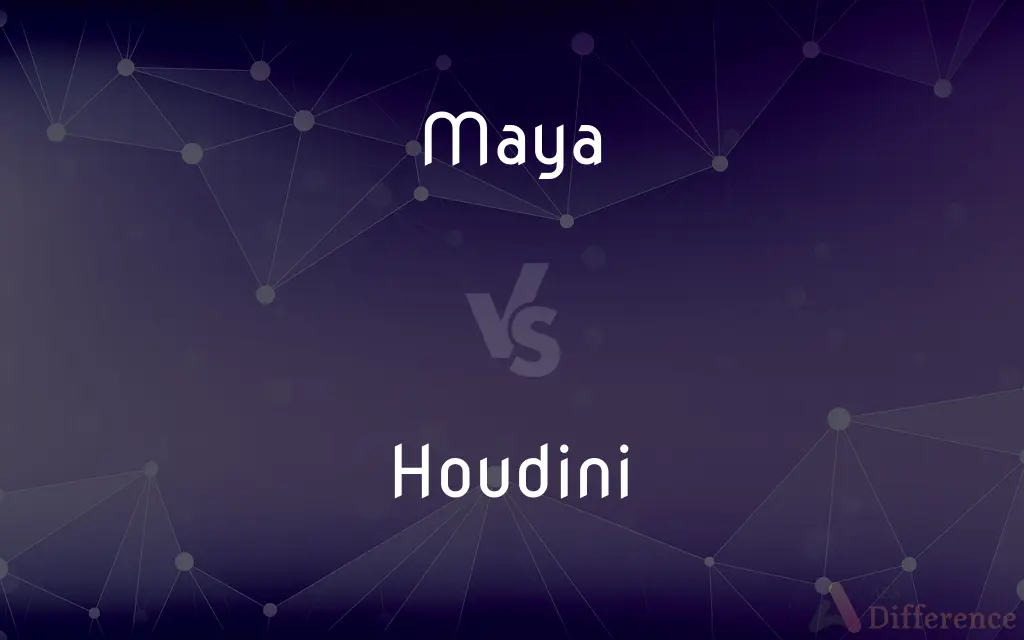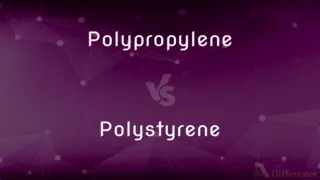Maya vs. Houdini — What's the Difference?
By Maham Liaqat & Urooj Arif — Updated on April 18, 2024
Maya is primarily used for character animation and 3D modeling, focusing on detailed character rigs and animation tools, while Houdini specializes in procedural generation and effects, excelling in dynamics and simulation.

Difference Between Maya and Houdini
Table of Contents
ADVERTISEMENT
Key Differences
Maya is a popular software in the animation industry, known for its robust tools for character modeling, animation, and rendering. It offers extensive features for rigging and animating characters which are integral in film, television, and game development. On the other hand, Houdini is recognized for its procedural workflow, which allows for immense control and flexibility in creating complex simulations and effects. This makes it particularly powerful for visual effects in movies.
While Maya provides a comprehensive set of tools that cater to traditional modelers and animators, Houdini excels in the realm of dynamic simulations, including fluids, fire, and smoke. This specialization in simulation allows for highly realistic effects that can be difficult to achieve in Maya.
Maya's animation tools include a non-linear animation editor and a wide range of IK (inverse kinematics) solutions that simplify the animation of complex movements and interactions. Whereas, Houdini offers a unique node-based approach, where each action creates a new node that can be adjusted and connected to drive complex effects and animations.
Regarding the user interface and ease of use, Maya tends to be more user-friendly for artists familiar with traditional 3D modeling and animation workflows. Houdini, however, has a steeper learning curve due to its procedural nature, which can be initially challenging for new users.
Maya has strong support for third-party plugins and a vast user community that provides extensive learning resources, which enhances its accessibility and utility. Houdini, while also supporting plugins and having a community, is especially favored in the visual effects industry where its procedural capabilities are a significant advantage.
ADVERTISEMENT
Comparison Chart
Primary Use
Character animation, modeling
Procedural generation, effects
Industry Preference
Animation, gaming
Visual effects, simulations
Core Strength
Detailed character rigs
Dynamic and complex simulations
User Interface
User-friendly for traditional tasks
Node-based, steeper learning curve
Community and Support
Large, with extensive resources
Smaller, focused on VFX
Compare with Definitions
Maya
Rendering engine.
Maya includes powerful rendering options for high-quality visual output.
Houdini
Dynamic simulations.
Houdini is used for creating complex dynamic simulations like explosions.
Maya
3D modeling software.
Maya is commonly used to create detailed 3D models for video games.
Houdini
VFX industry standard.
Houdini is a preferred tool in the VFX industry for its procedural capabilities.
Maya
Animation tool.
Maya's advanced animation tools help animators bring characters to life.
Houdini
Effects generation.
Houdini excels in creating realistic simulations of natural phenomena.
Maya
Simulation features.
Maya provides basic simulation tools for effects like cloth and hair.
Houdini
Procedural workflow software.
Houdini uses a node-based procedural workflow for creating effects.
Maya
Plugin support.
Maya allows for the integration of numerous plugins to enhance its capabilities.
Houdini
Node-based interface.
Houdini’s interface utilizes nodes which offer flexibility in effects creation.
Maya
A member of a Mesoamerican Indian people inhabiting southeast Mexico, Guatemala, and Belize, whose civilization reached its height around AD 300-900. The Maya are noted for their architecture and city planning, their mathematics and calendar, and their hieroglyphic writing system.
Houdini
United States magician (born in Hungary) famous for his ability to escape from chains or handcuffs or straitjackets of padlocked containers (1874-1926)
Maya
A modern-day descendant of this people.
Maya
Any of the Mayan languages, especially Quiché and Yucatec.
Maya
In Hinduism, Buddhism, and certain other East Asian religions, the transitory, manifold appearance of the sensible world, which obscures the undifferentiated spiritual reality from which it originates; the illusory appearance of the sensible world.
Maya
(Hinduism) The power of a god or demon to transform a concept into an element of the sensible world.
Maya
Magic; supernatural power as held by the gods.
Maya
The power by which the universe is made to appear; the illusion of the phenomenal world, as opposed to its true or spiritual reality.
Maya
The name (in Vedantic philosphy) for the doctrine of the unreality of matter, called, in English, idealism; hence, nothingness; vanity; illusion.
Maya
The Hindu goddess personifying the power that creates phenomena.
Maya
The power to produce illusions.
Maya
The Indian people occupying the area of Veracruz, Chiapas, Tabasco, Campeche, and Yucatan, together with a part of Guatemala and a part of Salvador. The Maya peoples are dark, short, and brachycephalic, and at the time of the discovery had attained a higher grade of culture than any other American people. They cultivated a variety of crops, were expert in the manufacture and dyeing of cotton fabrics, used cacao as a medium of exchange, and were workers of gold, silver, and copper. Their architecture comprised elaborately carved temples and palaces, and they possessed a superior calendar, and a developed system of hieroglyphic writing, with records said to go back to about 700 a. d.
Maya
The language of the Mayas.
Maya
A member of an American Indian people of Yucatan and Belize and Guatemala who had a culture (which reached its peak between AD 300 and 900) characterized by outstanding architecture and pottery and astronomy;
Mayans had a system of writing and an accurate calendar
Maya
An ethnic minority speaking Mayan languages and living in Yucatan and adjacent areas
Maya
A family of American Indian languages spoken by Mayan peoples
Common Curiosities
Is Houdini user-friendly for beginners?
Houdini has a steeper learning curve due to its procedural nature and is generally less intuitive for beginners compared to Maya.
What is Maya best used for?
Maya is best used for character animation and 3D modeling, particularly in the gaming and film industries.
Which software is more flexible for creating unique effects?
Houdini offers greater flexibility through its node-based procedural approach, making it superior for creating unique and complex effects.
What makes Houdini ideal for visual effects?
Houdini's procedural workflow and powerful dynamics simulation tools make it ideal for creating complex visual effects.
Which software is better for game development?
Maya is generally preferred in game development for its robust modeling and animation tools.
Which software has better support for plugins?
Maya has a broader range of supported plugins due to its larger user base and industry adoption.
Can Maya handle simulations like Houdini?
While Maya can handle basic simulations, Houdini is better suited for more complex and dynamic simulations.
Do professionals use both Maya and Houdini?
Yes, many professionals use both, choosing based on the specific needs of a project.
How do the rendering capabilities of Maya and Houdini compare?
Both Maya and Houdini have powerful rendering capabilities, but Maya is often preferred for its integrated solutions and third-party support.
Which software offers better educational resources?
Maya generally has more extensive educational resources available due to its widespread use in various industries.
How does the community support compare between Maya and Houdini?
Maya has a larger community with more widespread support, whereas Houdini’s community is highly specialized.
How does the cost of Maya and Houdini compare?
The cost can vary based on licensing options, but both are considered premium software with professional pricing tiers.
Can you integrate Maya and Houdini in a workflow?
Yes, many studios integrate both Maya and Houdini in their workflows to leverage the strengths of each.
What are the career opportunities for Maya and Houdini experts?
Career opportunities are excellent for both, with Maya experts finding roles in animation and gaming, and Houdini experts in visual effects.
What are the system requirements for each software?
Both require high-performance systems, but the specifics can vary with the version and complexity of tasks.
Share Your Discovery

Previous Comparison
Polypropylene vs. Polystyrene
Next Comparison
Test vs. QuizAuthor Spotlight
Written by
Maham LiaqatCo-written by
Urooj ArifUrooj is a skilled content writer at Ask Difference, known for her exceptional ability to simplify complex topics into engaging and informative content. With a passion for research and a flair for clear, concise writing, she consistently delivers articles that resonate with our diverse audience.














































